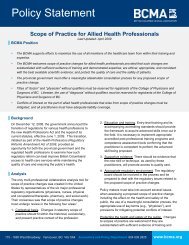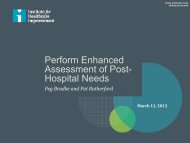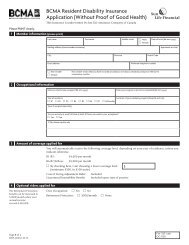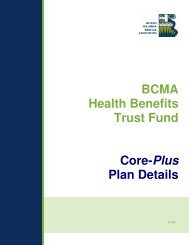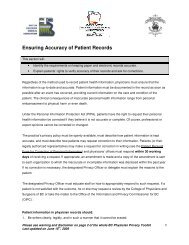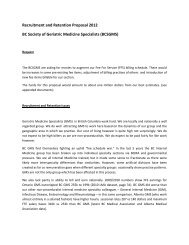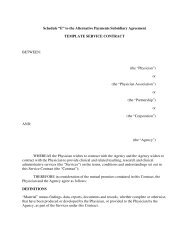Doctors Today and Tomorrow - British Columbia Medical Association
Doctors Today and Tomorrow - British Columbia Medical Association
Doctors Today and Tomorrow - British Columbia Medical Association
You also want an ePaper? Increase the reach of your titles
YUMPU automatically turns print PDFs into web optimized ePapers that Google loves.
III. The Current Workforce: Measuring supply <strong>and</strong> dem<strong>and</strong><br />
Several factors – an aging profession, intergenerational differences in workload expectations, <strong>and</strong><br />
growing dem<strong>and</strong> for health services – will continue to challenge efforts to maintain an adequate supply<br />
<strong>and</strong> mix of physicians. More robust <strong>and</strong> coordinated workforce management policies are necessary to<br />
ensure that the supply of physician services meets future dem<strong>and</strong>.<br />
Physician Supply in BC<br />
In keeping with the national trend, the total number of physicians in BC has increased over the past decade b . This<br />
increase is due to a number of factors, including having larger graduating classes from medical schools <strong>and</strong> hiring more<br />
foreign-trained doctors. Using data collected by the Canadian Institute of Health Information, the total number of BC<br />
physicians per 100,000 population increased at 9.3% between 1999 <strong>and</strong> 2009 (see Figure 4). Internationally, however,<br />
Canada’s 2.3 practising physicians per 1,000 population continued to remain well below the OECD average of 3.2 in<br />
2008 (OECD, 2010).<br />
Figure 4: Physicians per 100,000 Population, BC <strong>and</strong> Canada<br />
MD / 100,000<br />
215<br />
210<br />
205<br />
200<br />
195<br />
190<br />
185<br />
180<br />
175<br />
1999 2000 2001 2002 2003 2004 2005 2006 2007 2008 2009<br />
BC<br />
Canada<br />
Source: Canadian Institute for Health Information, Supply Distribution & Migration of Canadian Physicians, various years.<br />
Physician headcounts must be considered in the context of other factors, including changing demographics <strong>and</strong><br />
practice patterns, which to a certain degree can be captured in FTE counts. However, a st<strong>and</strong>ardized methodology for<br />
calculating physician FTEs based on all payment arrangements is lacking in BC.<br />
Projections by the Canadian <strong>Medical</strong> <strong>Association</strong> suggest that the existing BC physician-to-population ratios <strong>and</strong> FTEto-population<br />
ratios (based on hours of direct patient care) should continue on a slight upward trend over the next<br />
ten years, assuming that retirement rates, postgraduate exits, migration rates, <strong>and</strong> characteristics of the physician pool<br />
b<br />
Several physician databases may be used for tracking the overall number of active physicians in BC including the Canadian <strong>Medical</strong> <strong>Association</strong><br />
Masterfile, the <strong>Medical</strong> Services Plan fee-for-service database, the College of Physicians <strong>and</strong> Surgeons of BC, <strong>and</strong> Scott’s <strong>Medical</strong> Database. Making<br />
comparisons of physician counts from different databases can be difficult due to the variations in scope <strong>and</strong> the inclusion <strong>and</strong> exclusion criteria applied<br />
by each source, as well as the timing of their data collection.



